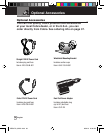
Nothing Comes Close to a Cobra
®
31
Understanding Radar and Laser
30
English
Your Detector
Understanding Radar and Laser
Your Detector
Strobe Alert
Special strobes mounted on the light bars of authorized emergency vehicles (fire
trucks, police cars, ambulances) automatically change traffic signals as the vehicle
approaches an intersection. These strobes and the special strobe detectors located
on the traffic signals, introduced fairly recently by 3M and Tomar, are already in
use in more than 1000 cities nationwide. Cobra’s exclusive Strobe Alert detector
will detect these special strobes and give an emergency vehicle alert.
When you receive such an alert, please watch for an approaching
emergency vehicle and pull over to allow it to pass. To inquire about
coverage in your area, contact your local fire and police departments.
LIDAR (Laser)
The correct name for the technology that most people refer to as laser is actually
LIDAR, which stands for Light Detection and Ranging.
LIDAR operates much like radar. Its signal spreads out like a radar signal, though
not as widely. Unlike radar, LIDAR must have a clear line of sight to its target
vehicle throughout the entire measurement interval. Obstructions such as sign
posts, utility poles, tree branches, etc., will prevent valid speed measurement.
Some common questions about LIDAR include:
g
Does weather have any affect on LIDAR?
Yes. Rain, snow, smoke, fog, or airborne dust particles will reduce the
effective range of LIDAR and can, if dense enough, prevent its operation.
g
Can LIDAR operate through glass?
Yes. Newer LIDAR guns can obtain readings through most types of glass.
However, the laser pulse also can be received through glass to trigger
an alarm by your detector.
g
Can LIDAR operate while in motion?
No. Because LIDAR operates by line of sight, the person using it cannot
drive the vehicle, aim and operate the gun all at the same time.
g
Is it legal for police to use LIDAR?
Yes, LIDAR is allowed to be used in all 50 States by police. Your detector
detects LIDAR (laser).
Understanding Radar and Laser
•
Radar Speed Monitoring Systems
Three band frequencies have been approved by the Federal Communications
Commission (FCC) for use by speed monitoring radar equipment:
X band 10.525 GHz
K band 24.150 GHz
Ka band 33.400 – 36.00 GHz
Your detector detects signals in all three radar bands, plus Ku band (13.435 GHz),
which is an approved frequency used in parts of Europe and Asia.
VG-2 and Spectre I & IV+
VG-2 and Spectre I & IV+ are radar detector detectors (RDDs) that work by
detecting low-level signals emitted by most radar detectors. Your detector does
not emit signals that can be spotted by VG-2 and Spectre I RDDs. However, your
detector can be spotted by Spectre IV+ RDDs. Your unit detects signals from
these or similar devices and will alert you when such
a device is in use near your vehicle.
Safety Alert Traffic Warning System
FCC-approved Safety Alert transmitters emit microwave radar signals that indicate
the presence of a safety-related concern. Depending on the frequency of the signal
emitted, it can indicate a speeding emergency vehicle or train,
or a stationary road hazard.
Because these microwave signals are within the K band frequency, most
conventional radar detectors will detect Safety Alert signals as standard
K band radar. Your detector, however, is designed to differentiate between
standard K band and Safety Alert signals, and give separate alerts for each.
Safety Alert technology is relatively new. Safety Alert transmitters can
be found in limited numbers in all 50 states, but the number is growing. Depending
on your location, you may not receive these alerts regularly
and may often encounter emergency vehicles, trains and road hazards
without being alerted. As the number of transmitters increases,
these alerts will become more common.
When you receive such an alert, please watch for emergency vehicles ahead
of you, on cross streets and behind you. If you see an emergency vehicle
approaching, please pull over to the right side of the road and allow it to pass.
XRS9770_MANL.indd 30-31 8/30/10 8:39 AM


















